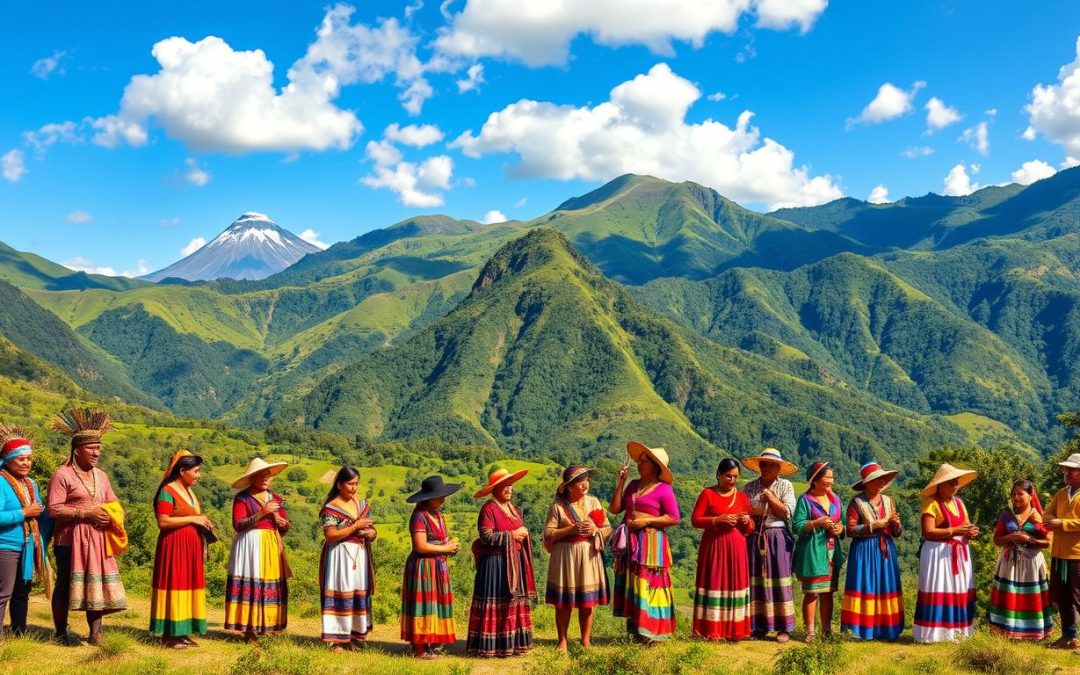Ever wondered how Ecuador, a small country, has such a rich mix of languages? Its language scene is a blend of Spanish and indigenous languages. This mix shows the country’s cultural strength and change over time.
Spanish is Ecuador’s official language, spoken by about 93% of people. But Ecuador’s story is more than just Spanish. It’s a tale of 24 different languages spoken across the country.
Ecuador’s language journey is a reflection of its cultural past. It started with Spanish brought by conquistadors in the 16th century. Then, indigenous languages like Kichwa and Shuar joined in. Today, Ecuador is a vibrant mix of languages that keeps growing.
Key Takeaways
- Spanish is the primary language, spoken by 93% of Ecuadorians
- 24 languages are recognized in Ecuador’s linguistic landscape
- Kichwa and Shuar are official languages for intercultural relations
- Three main Spanish dialects exist: Andean, Equatorial Pacific, and Amazonian
- Indigenous languages represent important cultural preservation efforts
Understanding Spanish as Ecuador’s Primary Language
Spanish is the main language in Ecuador, connecting millions of people. It shows the country’s rich culture and language variety. With about 13.5 million native speakers, it’s a key part of Ecuador’s identity.
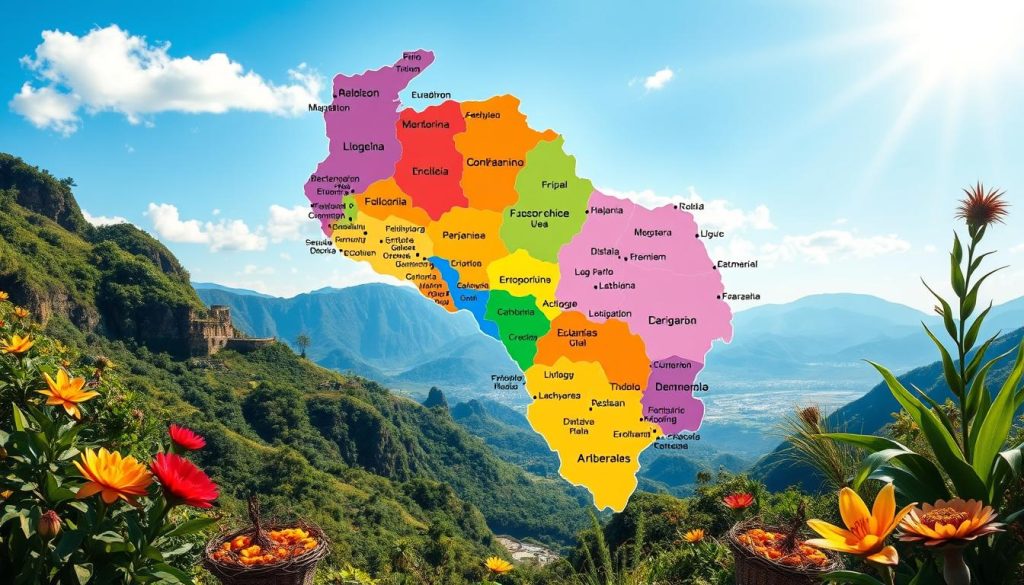
In Ecuador, Spanish is not the same everywhere. Each area has its own way of speaking, making communication rich and varied.
Regional Spanish Variations
Ecuador’s Spanish has three main types:
- Equatorial Coastal Spanish: Spoken along the coast
- Andean Spanish: Common in the highlands
- Amazonic Spanish: Used in the Amazon region
Impact on Business and Government
Spanish is key in Ecuador’s work world. It’s used in government, business talks, and schools. This shows its big role in the country’s life.
| Region | Spanish Dialect Characteristics |
|---|---|
| Coastal Region | Aspiration of -s sound, rapid speech patterns |
| Highland Region | Strong Quechua linguistic influences, unique pronunciation |
| Amazon Region | Mixed indigenous language influences |
Urban vs Rural Spanish Usage
Urban and rural areas speak Spanish differently. Cities like Quito and Guayaquil have more standard Spanish. But, rural areas keep their unique dialects and indigenous language touches.
“Language is the road map of a culture. It tells you where its people come from and where they are going.” – Rita Mae Brown
Indigenous Languages in Modern Ecuador
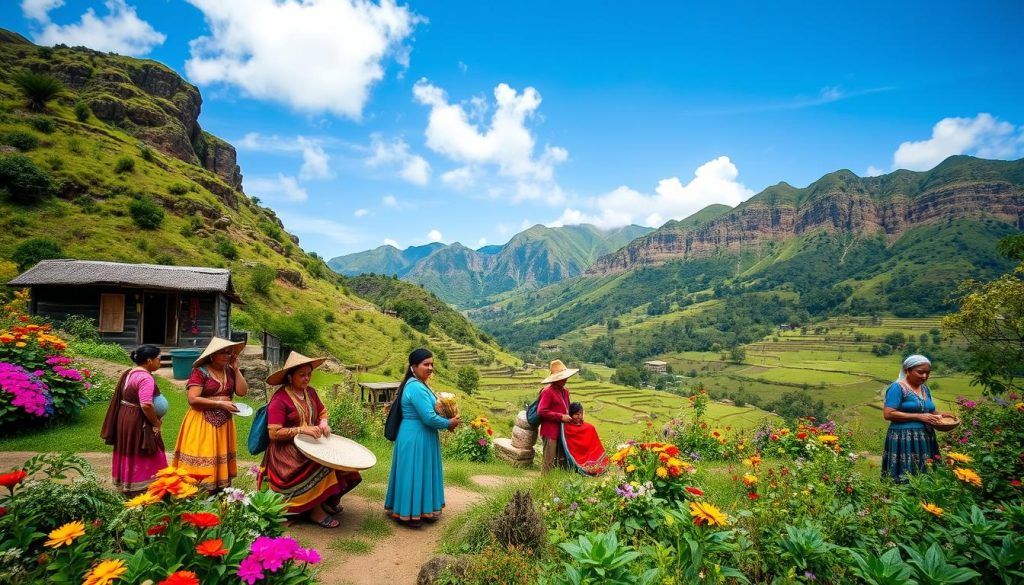
Ecuador’s language scene is full of life, with many indigenous languages still spoken today. Despite Spanish being the main language, 24 Amerindian languages are recognized. This shows the country’s rich cultural heritage.
The indigenous languages in Ecuador are very diverse. Ethnologue lists many languages across different areas. For example:
- Quechua (9 distinct varieties)
- Shuar language
- Cofán
- Waorani
- Achuar–Shiwiar
Exploring Ecuador’s indigenous languages is like discovering a cultural mosaic. About 7% of people identify as Indigenous. Most highland Indigenous communities speak both Spanish and their native language, mainly Quichua.
“Language is the roadmap of a culture. It tells you where its people come from and where they are going.” – Rita Mae Brown
Keeping these languages alive is very important. Schools are now teaching both Spanish and the native languages. This helps younger people stay connected to their roots while facing today’s world.
From the Amazon to the Andes, each language offers a special view of the world. They carry centuries of knowledge and cultural identity.
The Role of Quichua in Ecuadorian Society
Quichua is a vibrant indigenous language in Ecuador. It’s a key part of the country’s language scene. It connects communities and keeps cultural heritage alive. You’ll see how Quichua influences Ecuador’s social and educational life.
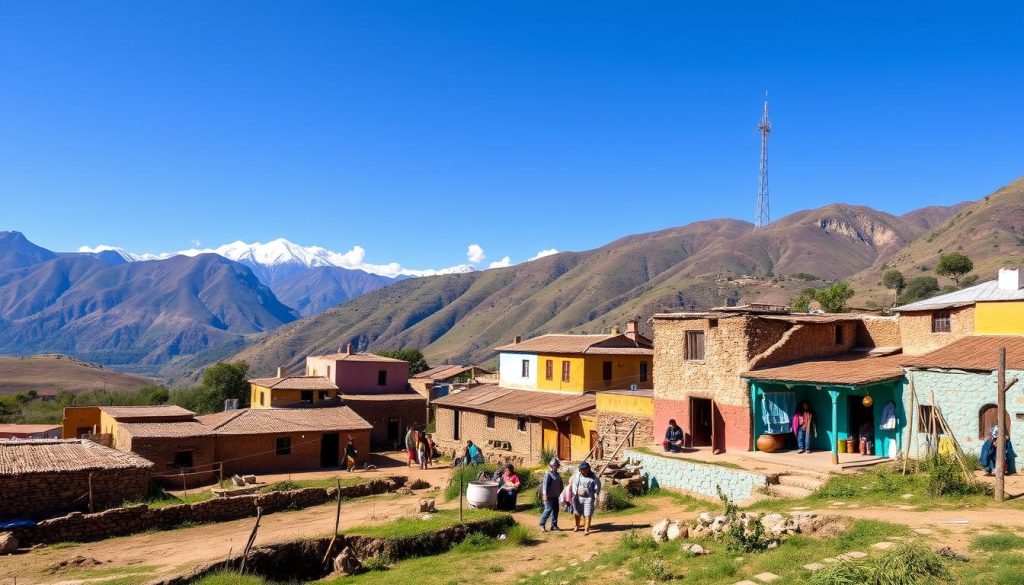
Distribution of Quichua Speakers
Quichua is spoken across Ecuador, showing its wide reach. Major areas with lots of Quichua speakers include:
- Chimborazo Province (highest concentration)
- Andean Highland regions
- Rural indigenous communities
About 7% of Ecuador’s people speak Quichua, which is around 450,000. This shows the country’s rich multilingual culture.
Educational Integration of Quichua
Ecuador is working hard to keep Quichua alive. The national curriculum now teaches Quichua. This lets young people learn and value their language heritage.
| Region | Quichua Speaker Percentage | Bilingual School Availability |
|---|---|---|
| Andean Highlands | 65% | High |
| Urban Centers | 15% | Moderate |
| Amazon Region | 20% | Growing |
Cultural Significance and Preservation
Quichua is more than a language; it’s a link to indigenous traditions. Cultural preservation efforts are key to saving linguistic diversity from globalization.
“Language is the road map of a culture. It tells you where its people come from and where they are going.” – Rita Mae Brown
Shuar Language and Its Cultural Heritage
Explore the vibrant Shuar language, a key part of indigenous languages and cultural identity in Ecuador. It’s spoken by about 50,000 people. This language is found in the southeastern provinces of Morona Santiago and Pastaza. It’s a vital part of the region’s language diversity.
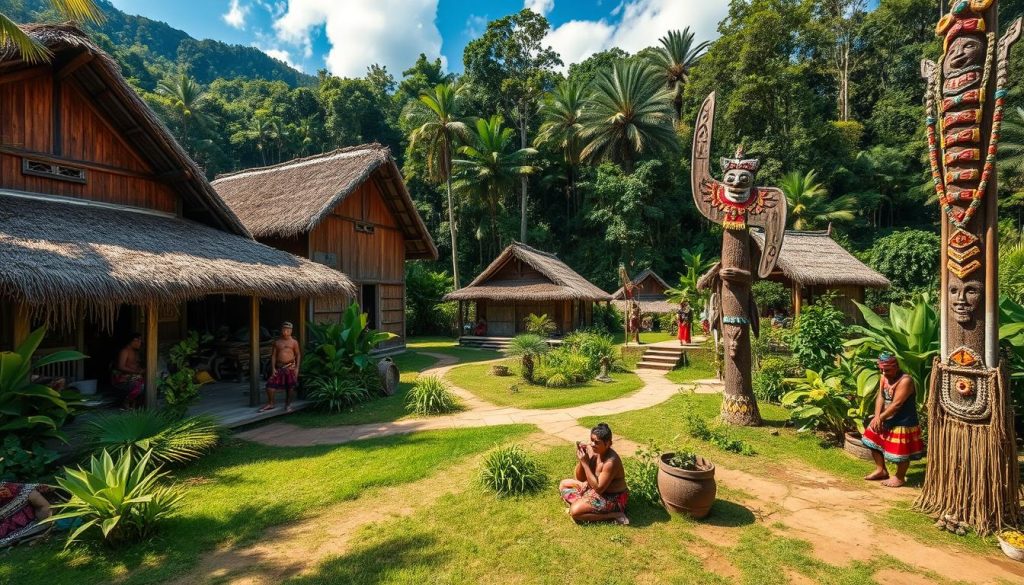
The Shuar language is part of the Jivaroan family. It holds a deep cultural heritage. For the Shuar, language connects them to their ancestors. It keeps their stories, knowledge, and social practices alive for generations.
“Our language is not just words; it is the heartbeat of our culture and identity.” – Shuar Community Elder
- Total Shuar population: approximately 100,000
- Language speakers: over 50,000
- Primary geographical concentration: Southeastern Ecuador
The Shuar Federation, started in 1964, has been key in protecting their language and culture. Their work helps keep the Shuar language strong, even with modern changes and outside influences.
Learning the Shuar language lets us see a strong and enduring indigenous culture. It shows how they keep their traditions alive, even as they adapt to new times. This language is a powerful way for them to express their culture and stand strong.
Bilingualism and Language Diversity in Ecuador
Ecuador’s language scene is a colorful mix of many tongues. About 25% of people speak two languages. This shows the country’s strong support for keeping languages alive.
Looking at how people use languages in Ecuador is really interesting. It shows how different groups interact through language. This helps us understand how communication works in society.
Gender Differences in Bilingual Proficiency
Studies have found interesting differences in language skills between men and women. In indigenous communities, there are special language patterns:
- Most indigenous males are bilingual
- Women are increasingly becoming bilingual
- Younger generations show higher bilingual rates
Urban-Rural Language Patterns
The way people speak changes a lot between cities and countryside. Cities mainly speak Spanish, but rural areas keep their indigenous languages like Kichwa alive.
“Language is the road map of a culture. It tells you where its people come from and where they are going.” – Rita Mae Brown
Educational Initiatives for Language Preservation
Ecuador’s schools are key in keeping languages alive. The Bilingual Intercultural System of Education (SEIB) helps by teaching both Spanish and indigenous languages:
- Early education is 100% in Kichwa
- High school classes mix Kichwa, Spanish, and foreign languages
- Support for indigenous language teachers continues
These efforts show Ecuador’s dedication to its diverse languages. They also help prepare the next generation for a world that speaks many languages.
Ecuador: Official and Widely Spoken Languages
Ecuador’s language scene is rich and varied. Spanish is the main official language, but indigenous languages are key to the country’s culture. This mix of languages shows the complex communication and heritage of Ecuador.
Spanish is a big part of Ecuadorian life, with about 93% of people speaking it. The Spanish spoken in Ecuador has its own special features:
- Andean Spanish influenced by Quichua
- Coastal Spanish with unique linguistic characteristics
- Amazonian Spanish reflecting regional diversity
Ecuador values its indigenous languages too. The country officially supports 13 indigenous languages. Kichwa and Shuar get special status, showing Ecuador’s effort to keep language diversity alive.
“Language is the road map of a culture. It tells you where its people come from and where they are going.” – Rita Mae Brown
Here are some key facts about Ecuador’s languages:
- Kichwa speakers: Between 1-2 million
- Shuar speakers: Approximately 35,000
- Total indigenous languages: 13
Ecuador sees language as more than just talking. It’s about keeping culture alive and respecting indigenous heritage. The country works hard to teach many languages and celebrate its diversity.
Language Distribution Across Ecuadorian Regions
Ecuador’s language scene is as varied as its stunning landscapes. The country’s unique areas shape how people talk, showing off its rich culture.
Looking at language across Ecuador gives us a peek into its cultural heart. Let’s dive into how language varies in different spots:
Coastal Language Patterns
On the coast, Spanish is the main language, with 93% of Ecuadorians using it. Cities have a standard Spanish, but rural areas have their own special ways of speaking.
Highland Language Usage
In the highlands, things are different. About 30% of people speak Quechua, besides Spanish. Chimborazo Province has the most Quechua speakers, showing the language’s strength in indigenous groups.
Amazonian Language Distribution
The Amazon is Ecuador’s most language-rich area. Here, Spanish and indigenous languages coexist:
- Shuar language is spoken by about 30,000 people
- Mostly found in Morona Santiago and Pastaza Provinces
- At least 7 different indigenous groups live in the Amazon
| Region | Primary Languages | Percentage of Speakers |
|---|---|---|
| Coastal Region | Spanish | 93% |
| Highland Andes | Spanish, Quechua | Spanish: 93%, Quechua: 30% |
| Amazon Rainforest | Spanish, Shuar, Indigenous Languages | Spanish: 93%, Indigenous Languages: Varied |
“Language is the roadmap of a culture. It tells you where its people come from and where they are going.” – Rita Mae Brown
This variety in language shows Ecuador’s effort to keep indigenous tongues alive while Spanish remains the official language.
Impact of Migration on Language Evolution
Migration has changed Ecuador’s language scene a lot. It has made a mix of cultures and languages. About 3.6% of the world’s people live in a country not their own. Ecuador sees a lot of language changes because of people moving in and out.
Migration has made language change in interesting ways. People from Colombia and Peru have brought new ways of speaking to Ecuador. These changes show how language can adapt and grow.
“Language is a living organism that grows and changes with human movement” – Anonymous Linguist
- Colombian immigrants bring coastal Spanish dialects
- Peruvian migrants introduce highland linguistic nuances
- Ecuadorian emigrants create transnational linguistic communities
Studies show immigrants face challenges in learning the local language. They often have jobs that don’t match their education. This can affect how they use and adapt to language.
| Migration Type | Linguistic Impact | Cultural Significance |
|---|---|---|
| Internal Migration | Dialect Mixing | Enhanced Language Diversity |
| International Immigration | Vocabulary Expansion | Cultural Exchange |
| Emigration to USA | Transnational Language Networks | Preservation of Cultural Identity |
Ecuador’s language scene keeps changing. It shows how migration, culture, and language mix. Each move tells a story of how people adapt and connect.
Conclusion
Your journey through Ecuador’s language landscape shows a vibrant tapestry of cultural identity. With over twenty recognized languages, Ecuador is a testament to linguistic diversity. Spanish is the official language, spoken by 98.7% of the population. But the nation’s true richness lies in its indigenous languages like Quichua and Shuar.
The language patterns in Ecuador reflect its complex social fabric. Bilingualism is key for cultural preservation and social mobility. Language in Ecuador is more than just communication. It’s a bridge connecting generations, preserving traditional knowledge, and celebrating the country’s rich multicultural heritage.
As Ecuador moves toward 2030, language will continue to play a crucial role in national identity. The nation is committed to protecting indigenous languages while embracing Spanish. This shows a nuanced approach to cultural preservation. Understanding Ecuador’s linguistic landscape highlights how language diversity strengthens national unity and individual cultural expression.
The future of Ecuador’s languages looks promising. With ongoing efforts to document, protect, and promote linguistic diversity, Ecuador stands as a global example of cultural resilience. Whether you’re a linguist, traveler, or cultural enthusiast, Ecuador’s language story offers profound insights into the power of communication and cultural identity.
The above is subject to change.
Check back often to TRAVEL.COM for the latest travel tips and deals.
Here are some Tours & Sightseeing suggestions that might pique your interests!
